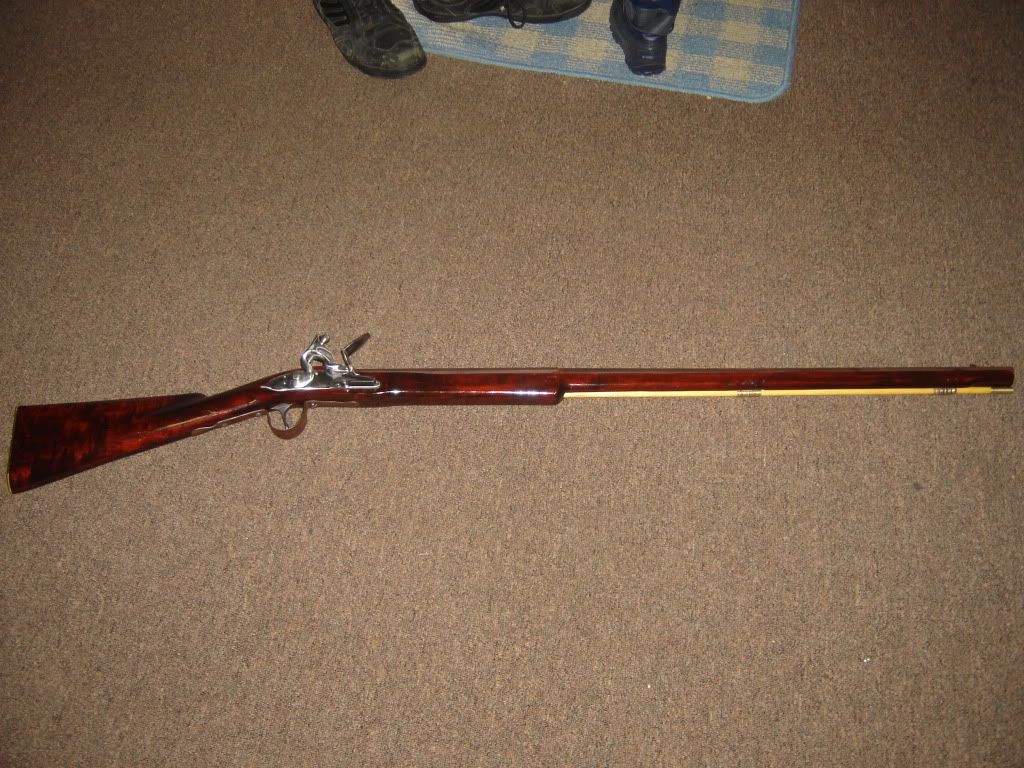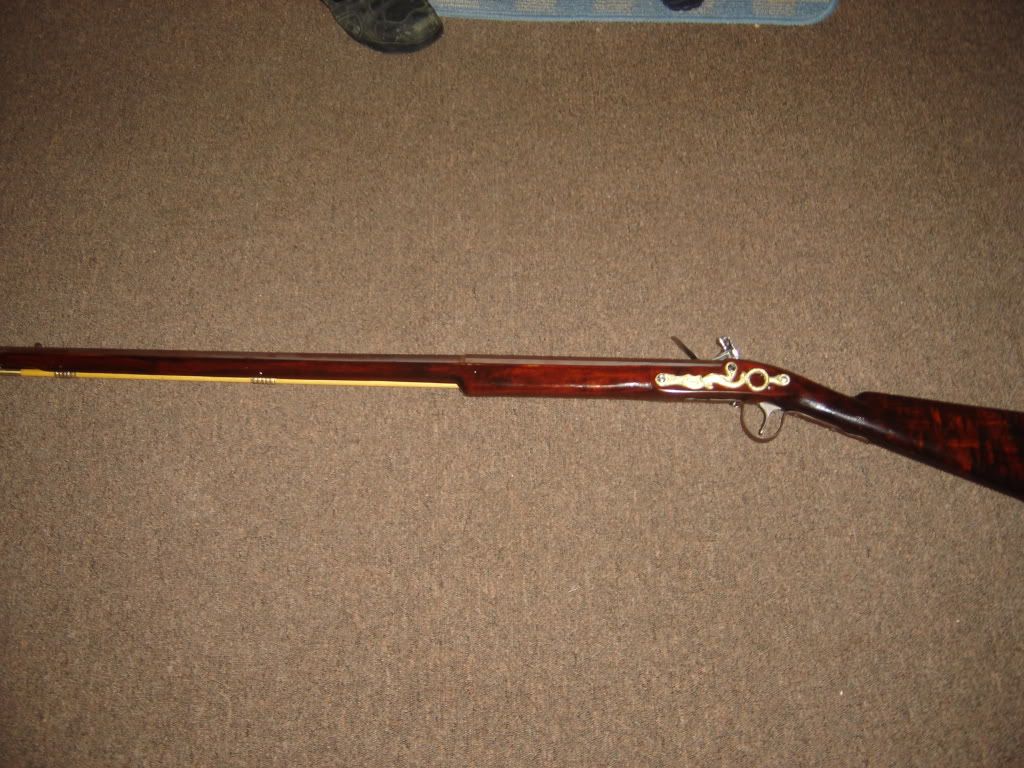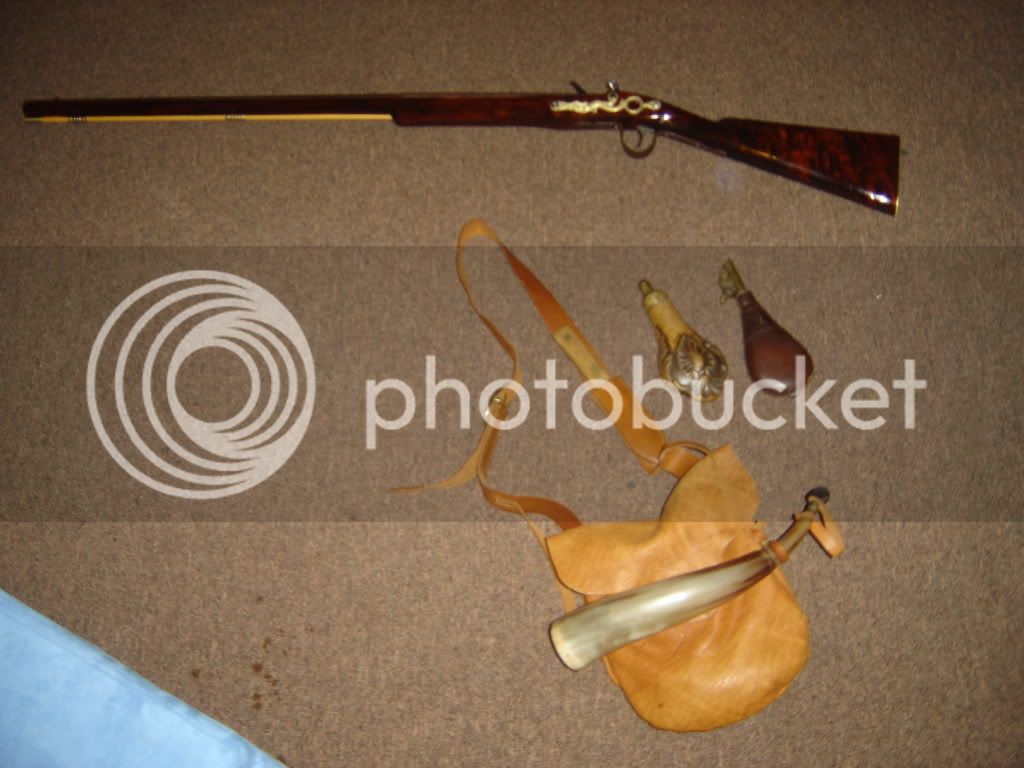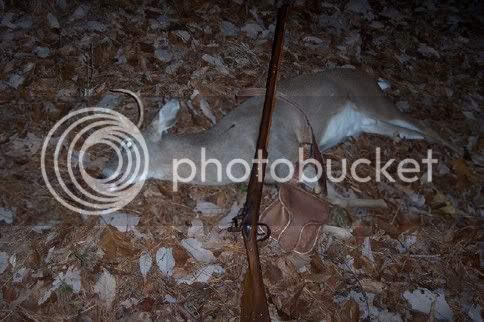-
Friends, our 2nd Amendment rights are always under attack and the NRA has been a constant for decades in helping fight that fight.
We have partnered with the NRA to offer you a discount on membership and Muzzleloading Forum gets a small percentage too of each membership, so you are supporting both the NRA and us.
Use this link to sign up please; https://membership.nra.org/recruiters/join/XR045103
You are using an out of date browser. It may not display this or other websites correctly.
You should upgrade or use an alternative browser.
You should upgrade or use an alternative browser.
Northwest Trade Rifles - Lets see em
- Thread starter pronghorn
- Start date

Help Support Muzzleloading Forum:
This site may earn a commission from merchant affiliate
links, including eBay, Amazon, and others.
poordevil
50 Cal.
- Joined
- Feb 17, 2008
- Messages
- 1,251
- Reaction score
- 8
I have no experience with others,(except Early Rustic Arms) but I really like my 2 North Star West trade guns. One is 24 ga and 36"BBL and the other is Canoe Gun, 20" BBL and 16ga....that one is super cool. You will not be sorry with NSW.
A warning! do not go with Early Rustic Arms. Their prices seem good, but it appears no one has gotten a gun from them in over a year.....Go with NSW! The service is first rate
P
A warning! do not go with Early Rustic Arms. Their prices seem good, but it appears no one has gotten a gun from them in over a year.....Go with NSW! The service is first rate
P
poordevil
50 Cal.
- Joined
- Feb 17, 2008
- Messages
- 1,251
- Reaction score
- 8
ERA takes half deposit and tells you the build will take "about" a year, then over 2 years later still no gun....no returned phone calls.......
I don't know about anyone else, but when I am told "about a year" to me that means 10 months to about 14 months.......not 2 years with no end in sight.
If you are going to spend your money get a NSW gun or TVM.....never ERA
this is the last I will say about it here....sorry for the hijack.......those of you who can post pics, please post some for
Mr. Pronghorn so he can see some of your fine Trade Guns
P
I don't know about anyone else, but when I am told "about a year" to me that means 10 months to about 14 months.......not 2 years with no end in sight.
If you are going to spend your money get a NSW gun or TVM.....never ERA
this is the last I will say about it here....sorry for the hijack.......those of you who can post pics, please post some for
Mr. Pronghorn so he can see some of your fine Trade Guns
P
I have had two NStar West guns a NW gun and a Chiefs gun I cannot seem to find thepics right now, at any rate I think that N Starr West pretty much sets the standard for the NW gun as far as ordering one pre built or a parts set, great quality and they keep real close on the historical accuracy as well, stay away from those who will sell you a barrel that is strait in the oct section (no taper) to me they are neither eye pleasing or come to the eye and shoulder as well as a tapered barrel, there are builders who will make you a custom NW gun but N Starr gives a lot for the $$$ most NW guns offered are replicas from the 1816-1840 time period if this is a factor.If you can find a club or group where you can wrap your hands around one of these this is always a good idea before buying a new style of gun.Walnut is the best choice of wood, most originals wre .58 but many use the .62 for the advantage of more shot and state requirements for some game birds good luck your quest these guns are a lot of fun to shoot, I quit shooting rifles after I started using smootbores. I find they do all I need as I do not find the need very often for shots past 50 yds.
I don`t have a way to post pics of mine.  But,I bought a used NSW Trade Gun 58 cal.this summer.I realy like it. :thumbsup: I got a smoothie because I want to hunt big game and small game. :wink: I only shot about 90 balls out of it.I want to try some shot out of it this weekend.Squirrel and turkey is comeing in soon. :applause:
But,I bought a used NSW Trade Gun 58 cal.this summer.I realy like it. :thumbsup: I got a smoothie because I want to hunt big game and small game. :wink: I only shot about 90 balls out of it.I want to try some shot out of it this weekend.Squirrel and turkey is comeing in soon. :applause:
Timothy Gregory
36 Cal.
- Joined
- Aug 11, 2007
- Messages
- 69
- Reaction score
- 0
I have a "chiefs" model although I don't know who originally made it. It's .62 cal and I bought it from a brother at my gun club. It is a game getter for sure! I have taken an 8 point white tail and numerous squirrels. Not to mention winning a few smooth bore competitions at the club. Wouldn't get rid of it for anything. 45 yards with a .600 ball w/65 gns of 3f punched the ball completely through the rib/heart/ribs of the white tail. A hand full of #6 shot can reach the top of the tallest hicory trees. I cannot gush enough about this gun!!!
- Joined
- May 9, 2005
- Messages
- 1,548
- Reaction score
- 100
Here's mine, although it's neither a rifle nor a Northstar West gun. It's an old Bill Douglas 16 ga, and the length of barrel- 26" -was determined by what Numrich Arms had in stock among their shotgun barrels. Still, I like it a lot!






matt denison
54 Cal.
- Joined
- Aug 15, 2004
- Messages
- 1,786
- Reaction score
- 14
That's an amazing piece of wood. Beautiful.
:thumbsup:
:thumbsup:
- Joined
- May 9, 2005
- Messages
- 1,548
- Reaction score
- 100
Thanks! Coming from someone who sees a lot of nice wood, and makes some wonderful guns (and kits) from it, that's nice to hear.
pronghorn said:Been looking at northwest rifles lately, Really like the North Star West guns. Your thoughts on that type of gun, (.62 smoothbore), and those from other gun builders. It will be my first smoothie.
Pictures please!
My Thoughts?
I like mine.
The Turkey didn't think too highly of it. :blah:

Barrel length is just a matter of personal choice. I'd get the 36".
The list is taken from Connor, "Sucess in the Fur Trade", and he got them from the orders of Pierre Chouteau Jr. & Co., for the Upper Missouri trade.
1850
W. Chance Son & Co., Birmingham
160--36 inch Barrels
110--42"
10---48"
Schuckard & Gebhard [importers],
Belgium guns
60--30 inch barrels
60--33"
60--36"
40--42"
English guns
300--30"
200--33"
200--36"
1851
W. Chance son & Co.
120--30"
170--33"
230--36"
40---42"
30---48"
Edw. K. Tryon, Philadelphia
47--30"
3---36"
1852
W. Chance Son & Co.
150--30"
150--33"
250--36"
30---39"
40---42"
30---48"
1853
W. Chance Son & Co.
60--30"
50--33"
90--36"
20--39"
1854
W. Chance Son & Co.
150--30"
150--33"
180--36"
80---39"
40---42"
1855
W. Chance Son & Co.
150--30"
150--33"
120--36"
20---42"
The above is from Connor, "Success in the Fur Trade". He took it from the microfilm of the PCJ&Co. records. Notice that the 30" and 33" barrels get increasingly popular over the five years, while the 42" barrels are ordered less and less. It's very surprising that the 48" barrels were still available as late as 1852.
Now, as for resons why those barrels were shortened even further:
"When running buffaloes the hunters do not use rifle-patches but take along several balls in their mouths; the projectile thus moistened sticks to the powder when put into the gun. In the first place, on buffalo hunts, they do not carry rifles, for the reason that they think the care required in loading them takes too much time unnecessarily when shooting at close range and, furthermore, they find rifle balls too small. The hunter chases buffaloes at full gallop, discharges his gun, and reloads without slackening speed. To accomplish this he holds the weapon close within the bend of his left arm and, taking the powder horn in his right hand, draws out with his teeth the stopper, which is fastened to the horn to prevent its being lost, shakes the requisite amount of powder into his left palm, and again closes the horn. Then he grasps the gun with his right hand, holding it in a vertical position, pours the powder down the barrel, and gives the gun a sidelong thrust with the left hand, in order to shake the powder well through the priming hole into the touchpan (hunters at this place discard percussion caps as not practical).
Now he takes a bullet from his mouth and with his left hand puts it into the barrel, where, having been moistened with spittle, it adheres to the powder. He dares never to hold his weapon horizontal, that is, in position taken when firing, for fear the ball may stick fast in its course, allowing sufficient air to intervene between powder and lead to cause an explosion and splinter the barrel. So long as the ball rolls freely down there is no danger. Hunters approach the buffaloes so closely that they do not take aim but, lifting the gun lightly with both hands, point in the direction of the animal's heart and fire. They are very often wounded on the face and hands by the bursting gun barrels, which, especially when the weather is extremely cold, are shattered as easily as glass."
Rudolf Friedrich Kurz, Fort Union, 1851
The list is taken from Connor, "Sucess in the Fur Trade", and he got them from the orders of Pierre Chouteau Jr. & Co., for the Upper Missouri trade.
1850
W. Chance Son & Co., Birmingham
160--36 inch Barrels
110--42"
10---48"
Schuckard & Gebhard [importers],
Belgium guns
60--30 inch barrels
60--33"
60--36"
40--42"
English guns
300--30"
200--33"
200--36"
1851
W. Chance son & Co.
120--30"
170--33"
230--36"
40---42"
30---48"
Edw. K. Tryon, Philadelphia
47--30"
3---36"
1852
W. Chance Son & Co.
150--30"
150--33"
250--36"
30---39"
40---42"
30---48"
1853
W. Chance Son & Co.
60--30"
50--33"
90--36"
20--39"
1854
W. Chance Son & Co.
150--30"
150--33"
180--36"
80---39"
40---42"
1855
W. Chance Son & Co.
150--30"
150--33"
120--36"
20---42"
The above is from Connor, "Success in the Fur Trade". He took it from the microfilm of the PCJ&Co. records. Notice that the 30" and 33" barrels get increasingly popular over the five years, while the 42" barrels are ordered less and less. It's very surprising that the 48" barrels were still available as late as 1852.
Now, as for resons why those barrels were shortened even further:
"When running buffaloes the hunters do not use rifle-patches but take along several balls in their mouths; the projectile thus moistened sticks to the powder when put into the gun. In the first place, on buffalo hunts, they do not carry rifles, for the reason that they think the care required in loading them takes too much time unnecessarily when shooting at close range and, furthermore, they find rifle balls too small. The hunter chases buffaloes at full gallop, discharges his gun, and reloads without slackening speed. To accomplish this he holds the weapon close within the bend of his left arm and, taking the powder horn in his right hand, draws out with his teeth the stopper, which is fastened to the horn to prevent its being lost, shakes the requisite amount of powder into his left palm, and again closes the horn. Then he grasps the gun with his right hand, holding it in a vertical position, pours the powder down the barrel, and gives the gun a sidelong thrust with the left hand, in order to shake the powder well through the priming hole into the touchpan (hunters at this place discard percussion caps as not practical).
Now he takes a bullet from his mouth and with his left hand puts it into the barrel, where, having been moistened with spittle, it adheres to the powder. He dares never to hold his weapon horizontal, that is, in position taken when firing, for fear the ball may stick fast in its course, allowing sufficient air to intervene between powder and lead to cause an explosion and splinter the barrel. So long as the ball rolls freely down there is no danger. Hunters approach the buffaloes so closely that they do not take aim but, lifting the gun lightly with both hands, point in the direction of the animal's heart and fire. They are very often wounded on the face and hands by the bursting gun barrels, which, especially when the weather is extremely cold, are shattered as easily as glass."
Rudolf Friedrich Kurz, Fort Union, 1851
Rod Lassey
50 Cal.
- Joined
- Sep 5, 2007
- Messages
- 1,418
- Reaction score
- 10
Sounds like something I've read before :wink:
http://www.muzzleloadingforum.com/...5310/post/802108/hl/kurz/fromsearch/1/#802108
Rod
http://www.muzzleloadingforum.com/...5310/post/802108/hl/kurz/fromsearch/1/#802108
Rod
Last edited by a moderator:
DutchmanDick
40 Cal.
- Joined
- Mar 30, 2009
- Messages
- 192
- Reaction score
- 0
I built my 36" barrel, 20 gauge NWTG from a kit I bought from Sitting Fox Muzzleloaders. I lived in an apartment at the time, so I really didn't have any workshop facilities. I ordered my stock inletted for the barrel, ramrod, and a Davis trade gun lock. I used Dixie Gunworks Antique Stock Stain with a thick coating of Tru-Oil (I was trying to emulate the original cheap varnish finish), and browned all the iron parts except the lock, which I buffed bright. Tools used were a Dremel, surform plane, hand chisels, files, wood rasp and palm sander.






Keb
50 Cal.
.62 Northwest gun. Ash stock, Queen Anne lock:




.62 Centermark Tulle Fusil de Chasse:






.62 Centermark Tulle Fusil de Chasse:


Curly Gustomsky trade gun, 62cal. Only shot I have take at a deer with it, did just fine.

The high entrance hole was because I was in a treestand, the deer was facing me and had just spotted me. When I pulled the trigger the gun had a brief hangfire and the deer ducked when the pan flashed.

The high entrance hole was because I was in a treestand, the deer was facing me and had just spotted me. When I pulled the trigger the gun had a brief hangfire and the deer ducked when the pan flashed.
- Joined
- May 9, 2005
- Messages
- 1,548
- Reaction score
- 100
That ash makes a pretty stock, doesn't it? I have a percussion squirrel rifle in curly ash, and the figure sure pops.
Did you build the gun? Was there a reason, besides aesthetics, to build it in ash? It just seems an unusual choice for a NW trade gun, and I was wondering...
Did you build the gun? Was there a reason, besides aesthetics, to build it in ash? It just seems an unusual choice for a NW trade gun, and I was wondering...
Keb
50 Cal.
I didn't build it. I remember seeing JR Salvo (may he R.I.P.) shooting one he built years ago and always admired it. A fellow had this one and offered to trade for one of my smooth bores so I swapped him.
Similar threads
- Replies
- 10
- Views
- 613
- Replies
- 10
- Views
- 2K
- Locked
- Replies
- 20
- Views
- 3K




